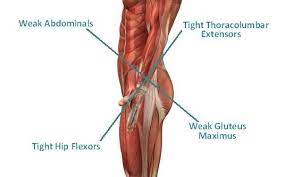Correcting Low Back Pain Caused by Lower Cross Syndrome
In Lower Cross Syndrome (LCS) Part I, we talked about what LCS is and what causes it. Now, we’ll get into how LCS is diagnosed, the best options for treating it, what you can expect from treatment.
LCS is the result of imbalances in muscle strength in the lower region of the body. This can also be referred to as pelvic crossed syndrome or distal crossed syndrome. Treatments are available for LCS, and because it can seriously affect other parts of your body, it’s not something you should leave untreated.
Treating Lower Cross Syndrome
 Whenever you’re experiencing any kind of neck back or joint pain, a chiropractor trained in spine biomechanics is a good choice for getting a proper diagnosis so you can get on the path to relieving your pain and enjoying better health overall.
Whenever you’re experiencing any kind of neck back or joint pain, a chiropractor trained in spine biomechanics is a good choice for getting a proper diagnosis so you can get on the path to relieving your pain and enjoying better health overall.
The goal in treating Lower Cross Syndrome is to eliminate your pain at the source that’s causing it. The best way to do that is through chiropractic treatment, physical therapy, postural retraining, and exercise. Your Fort Collins chiropractor will work to realign your neck, spine, and help restore joint health. A chiropractor will also make recommendations for stretching and strengthening exercises and instruct you how to perform them so you get the maximum benefit.
What to Expect from Treatment for LCS
LCS affects multiple muscle groups including your hip flexors, lumbar paraspinals, glutes and hamstrings. In LCS the hip flexors and lumbar spinal erector muscles become overactive while the abdominals glute maximus become underactive. The hamstrings frequently become tight as well. The pattern of hyperactive and weakening muscles that forms a cross patter causes and anterior tilting of the pelvis and increased curve in the lumbar spine. Treatments for LCS involve strengthening the weakened abdominals and glutes and lengthening the hip flexors and lumbar erectors.
Once you have a proper diagnosis, your chiropractor will develop a comprehensive, customized treatment program for you that includes some combination of chiropractic treatments, exercises, and postural retraining. If you live in northern Colorado look for a chiropractor in Fort Collins trained in Chiropractic Biophysics (CBP®). Doctors trained CBP have advanced knowledge in methods to correct spine deformities such as LCS and will provide treatments involving exercises, stretches, adjustments and traction to restore normal function and structure, including correcting spinal alignment.
What’s the Long-Term Prognosis for Lower Cross Syndrome?
The long-term prognosis for LCS is often very good, especially if you seek the right treatment early. Chiropractic care works well for LCS because it’s a conservative, non-invasive treatment that promotes natural healing.
For long-term recovery, it helps to avoid long periods of sitting. Do your best to move more and take breaks as needed to avoid undue strain on your body. It will also help to practice good posture whenever you’re sitting or standing. The exercises you learn will help you to maintain better core strength even after your formal treatment plan ends.
If you’re spending long hours sitting, reading, driving, watching TV, or reading, you could develop LCS. Left untreated, LCS can lead to pain, reduced flexibility, poor range of motion, and weakness. Over time, it can also cause degenerative changes in your back and neck. Chiropractic care is a good choice of treatment that can help you prevent LCS and help restore your strength and mobility. If you are dealing with low back pain call our Fort Collins back pain treatment center at 970-207-4463 or click here to request a FREE consultation.
